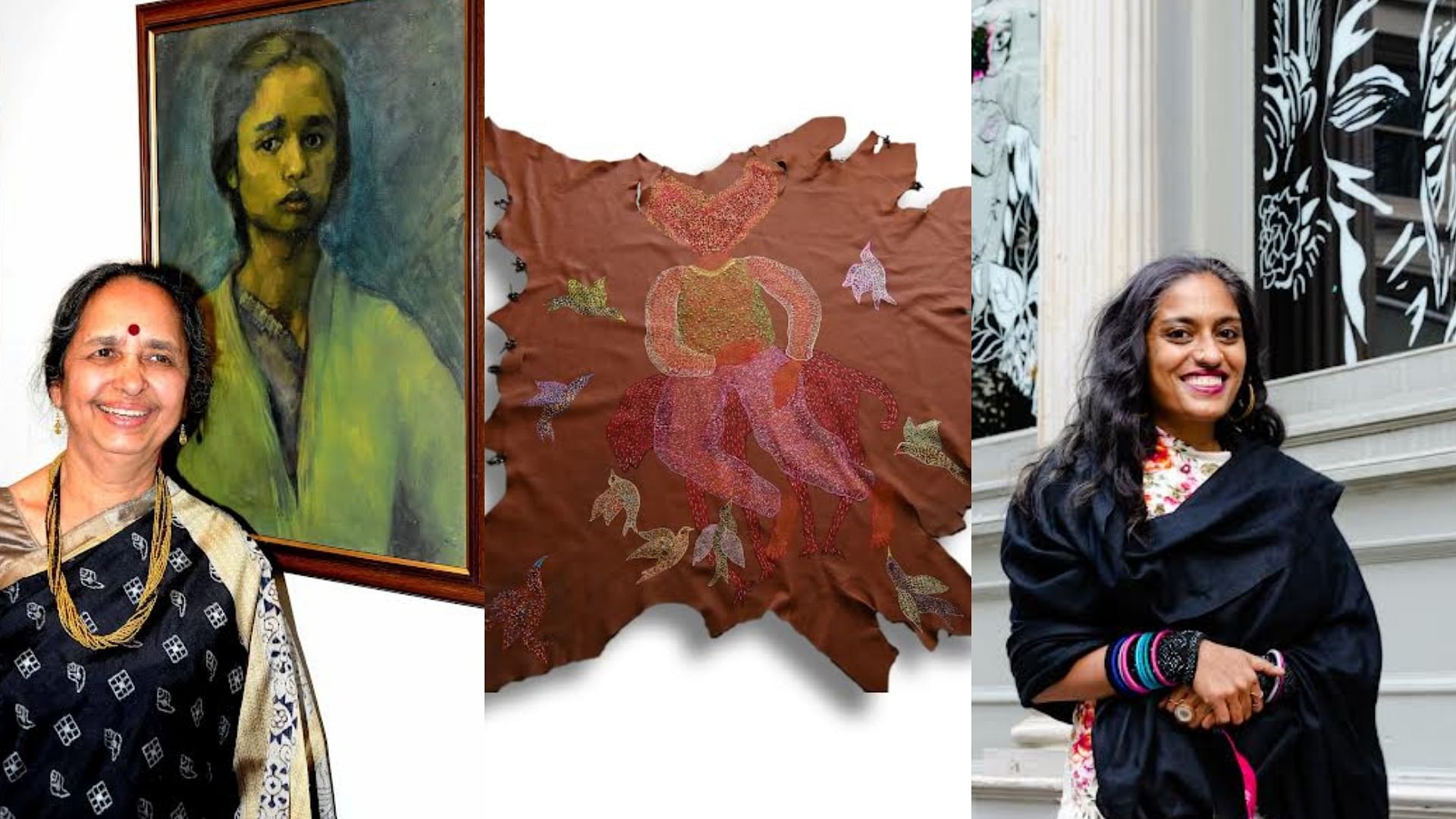
Shobha Broota (R), Debashish Paul (C), Chitra Ganesh (L)
Credit: Special Arrangement
The Indian creative community dazzled at Art Dubai, West Asia’s premier art fair held at the Madinat Jumeirah grounds earlier this month with marquee names like Mithu Sen, Harendra Kushwaha, G R Iranna, Chitra Ganesh, Shobha Broota and Mekhala Bahl, among others, showcasing their diverse and eclectic collections to an appreciative audience.
“Art Dubai is the pre-eminent art fair in west Asia, and one of the most exciting and fast developing art markets globally, attracting footfalls from a large and talented pool of international artists, curators, gallerists and collectors,” Renu Modi, founder-director of Gallery Espace, New Delhi, told the media.
Modi added that the forum is great for visibility, for the entire community, “which is why it has seen such a strong participation from Indian galleries in recent years.”
In its 17th edition this year, the fair showcased a plethora of global artistic talent with over 120 contemporary, modern, and digital presentations from 60 cities across 40 countries.
Divided into four sections—Art Dubai Contemporary, Art Dubai Digital, Art Dubai Modern, and 'Bawwaba'—it offered over 70,000 visitors from all over the world an immersive journey through a range of artistic perceptions, offering personal interpretations of reality from acclaimed artists.
Artistic director Pablo De Val described Art Dubai as more than just an art fair, underscoring its role as a vibrant gathering place for artistic communities.
"We offer a pathway for emerging and younger galleries and hope to reflect the diversity of these communities at this year’s event,” Val said.
The Art Dubai Contemporary section spotlighted artists primarily from the Global South, especially India. The 'Bawwaba' section, meaning "gateway" in Arabic, offered a curated selection of solo presentations centred around the theme of healing while Art Dubai Digital’s innovative use of immersive technologies pushed the boundaries of traditional artwork.
The Indian creatives concurred that Dubai has emerged as a formidable gateway for Indian artists offering a familiar culture and greater opportunities, given the UAE and other governments in the regions’ emphasis on cultural outreach.
“As a curator and gallerist, I’d say that Art Dubai's artist-first approach finds our enthusiasm. The approach guides more attention towards the artists and their back story to reach out through art making; it lets both the artist and the gallery grow ethically,” opined Ushmita Sahu, Director and Head Curator, Emami Art, Kolkata.
Dubai, added the gallerist, is a zone where contemporary showcases and rich cultural heritage meet the widest variety of international viewership.
“It brings together the most interesting and cutting-edge showcases, thought-provoking art beyond cartography, innovative curators, and cultural voices from the Middle East, Africa, Southeast Asia, and more.”
Gallery Espace, which is participating in Art Dubai this year after a hiatus of 15 years, showcased artists who represent a across section of approaches to contemporary painting practice in India today.
Among them were three recent drawings by New York-based Chitra Ganesh which drew from a repertoire of global and Indian visual sources from high art to popular culture.
Dilip Chobisa’s paper relief sculptures depicted fragments of the architecture of old quarters of Indian cities, where built-space becomes an extension of mindscapes. G. R. Iranna’s mixed-media on tarpaulin paintings of blooming trees represented existential dualities.
Also on display at the Gallery Espace booth were New Delhi-based Mekhala Bahl’s abstract works, created by an unorthodox mélange of techniques – printmaking, collage, drawing, quilting, photography, even sculpture. Harendra Kushwaha’s woven paper sculptures evoked the textures and contours of the remote village in Nepal where he grew up while the ‘woven paintings’ of Shobha Broota, one of India’s senior-most artists, depicted her unique vocabulary.
But perhaps the most lauded Indian artist at the fair was young Debashish Paul. The 30-year-old, just back from a residency in Paris, showcased a plethora of artworks represented by Emami Art Gallery. The solo booth at the 'Bawwaba' exhibited Paul's new drawings and photographs, along with a sculptural costume and headdress from a recent performance.
“Drawings are essential to my practice,” Paul told this correspondent at the fair. “They are crafted by pasting paper on fabric with drawings that carry visual lexicons of my memories, self, stories and imaginations of body and intimate metiers.”
Site-specific photography, added the artist, “is an extended part of my work where I appear in sculptural dresses, signifying certain connections and elements relating to the place and theme of my performance. The body and landscape in the photographs on view, blend in, resonating with each other.”
Blue chip Indian galleries like Vadehra Art Gallery, Experimenter, Latitude 28, Shrine Empire, Blueprint 2012, among others, were well represented at the fair. Chemould Prescott Road presented works by three women artists — Anju Dodiya, Dana Awartani and Mithu Sen — exploring themes of staining, pricking and mending in deeply personal ways showcasing a refreshingly novel artistic vocabulary.